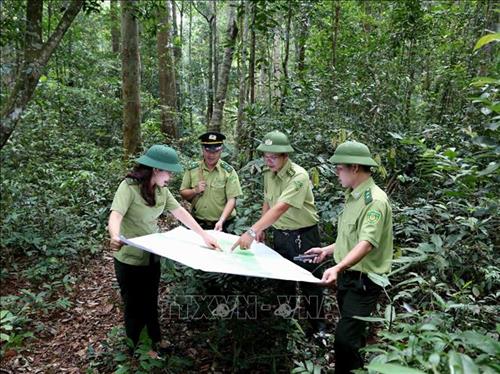 Environment
Environment


|
| Developing tourism and services in protective and special-use forests in parallel with conservation will become a key part of the national economy in the future.— VNA/VNS Photo Hữu Sinh - |
HÀ NỘI — Developing tourism and services in protective and special-use forests in parallel with conservation will become a key part of the national economy in the future.
“The forests will be an advantage for the country if they are managed effectively,” said Minister of Agricultural and Rural Development Nguyễn Xuân Cường at a national workshop on protective and special-use forest management held on Thursday in Hà Nội.
According to Cường protective and special-use forests play an important role as they have high biodiversity and are a place for the conservation of rare and precious plants and animals, tourism and service development and a valve regulating the climate for each sub-region.
Data from the ministry shows that the country now has 2.15 million hectares of protective forest and 4.6 million hectares of special-use forest.
It is estimated that 54 of 63 provinces and cities have protective forests and 59 of 63 provinces and cities have special-use forests. Đắk Lắk Province ranks first in having the largest area of special-use forest while Bạc Liêu Province has the smallest area of special-use forest. Nghệ An Province has the largest area of protective forest and Bắc Ninh Province has the smallest.
Cường asked the Việt Nam Administration of Forestry to pay more attention to the two kinds of forest.
It should concentrate on both conservation of biodiversity and economic development, rather than just focusing on conservation, he said.
There are 231 protective forest management boards and 164 special-use forest management boards throughout the country.
The administration was told to classify, assess and point out typical models to improve management.
Recommendations
Nguyễn Duy Thịnh, deputy head of Hoàng Liên National Park in the northern mountainous province of Lào Cai, said the park’s management board planned to submit a project to develop eco-tourism in the special-use forest soon.
Thịnh said the park currently managed two routes for tourists in the forest and charged fees. After collecting the fees, the park was allowed to keep 20 per cent while 80 per cent would be sent to the State budget.
He said the money the park kept was barely enough to pay salaries, with no money left to develop tourism. In the meantime, the demand for tourism was increasing.
Thịnh suggested the ministry allow the park to keep 90 per cent of the collected fees to invest in tourism development.
Nguyễn Quốc Trị, head of the Việt Nam Administration of Forestry, said management boards of protective and special-use forests were expected to gradually apply financial autonomy by collecting payments for forest environmental services and fees from developing eco-tourism.
By 2025, it was hoped that half of protective and special-use forests would run eco-tourism services. — VNS